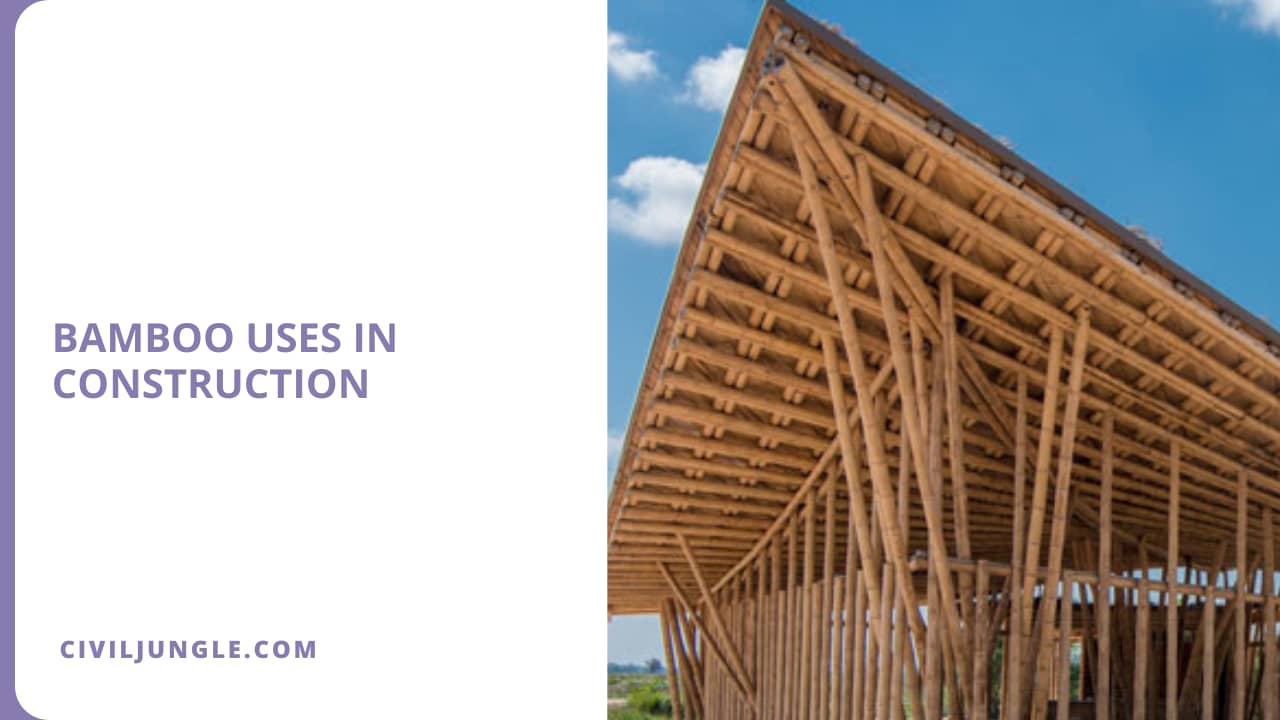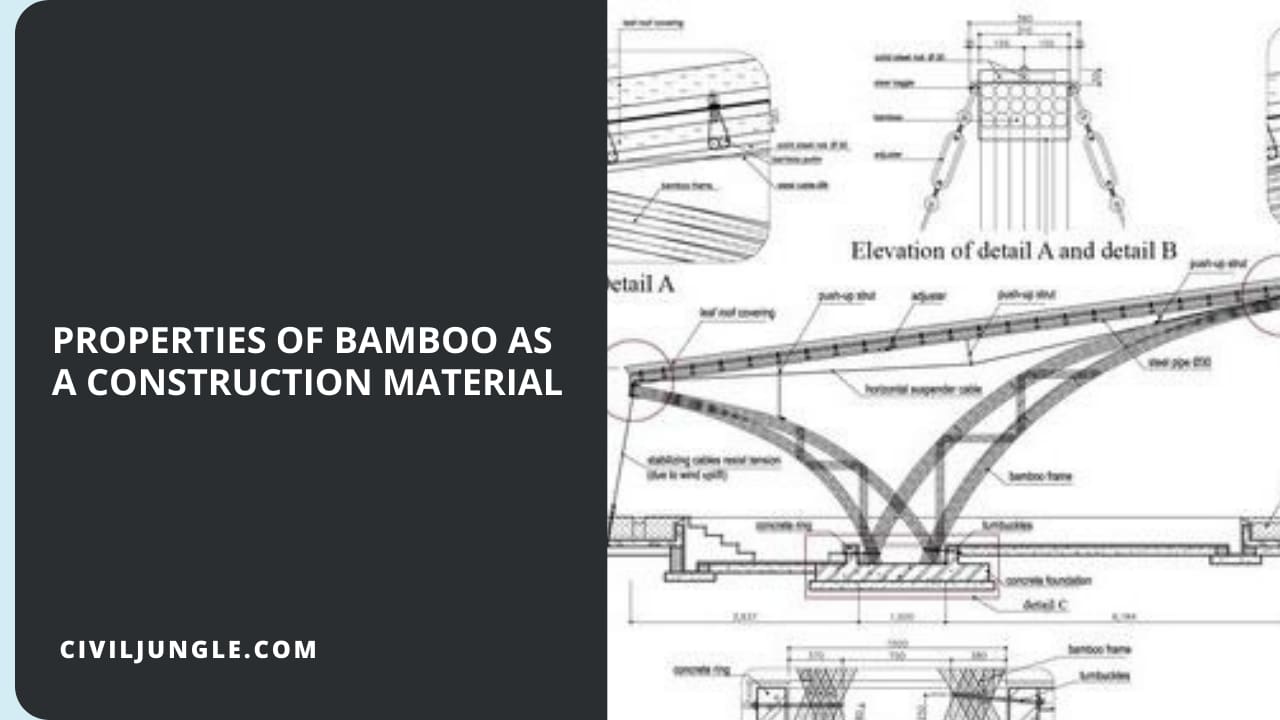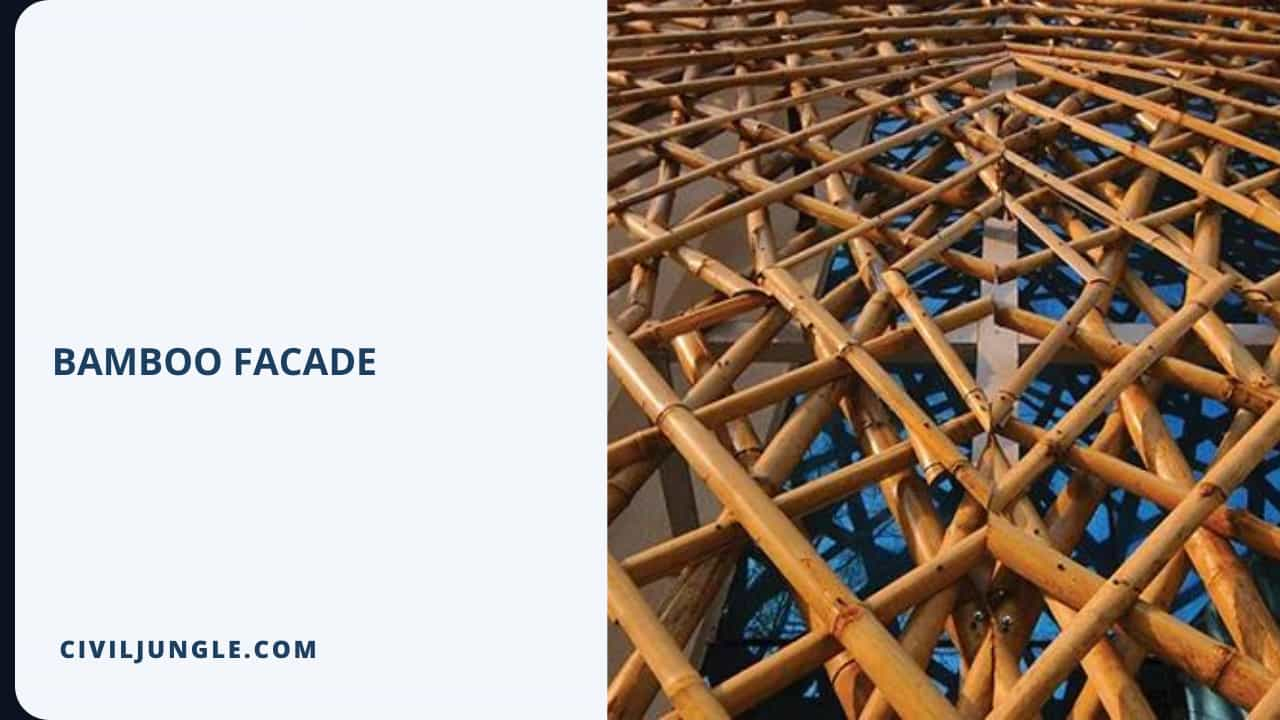Introduction of Bamboo
Important Point
- Bamboo is one of the oldest and traditional bamboo construction materials used in different construction activities.
- The bamboos strength it is more as compared to other construction material. Bamboo as a building material has greater compressive strength and it is lightweight so that it is widely used as a construction material.
- In this article, you will get to know about the uses of bamboo in construction as a construction material and different properties of bamboo.
- The demand for timber is increasing day by day all over the world. But due to short supply of timber, the bamboo is suitably used as a replacement of the construction material. Bamboo is also recently started using different types of designer homes.
- Bamboo is widely used in the construction industry for various purposes such as scaffolding, bamboo used in construction of bridges and structures, etc.
- Bamboo defines as a tall tropical plant with hard and hollow stems. Bamboo is a natural product which is widely used in the bamboo in construction of partition walls, bamboo flooring, and ceiling panels and for roofing.
- Bamboo is one of the fastest-growing plants in all over the world. Bamboo is a renewable resource which can be cultivated in different types of soil and used as bamboo as building material.
- Bamboo has referred mostly in the earthquake-prone regions due to its elastic properties.
- Bamboo is widely used for the construction of partition walls and beams which are the main structural elements of any structure.
- Bamboo is the best option for the roofing material and widely used by the people in the bamboo building materials for the construction of structures especially where bamboo is in abundance.
- The bamboo roof is very popular and widely used in the construction of homes which gives aesthetical look to the roof of the home.
- Bamboo has a natural surface which is smooth and clean and very attractive and does not require painting. That’s why it is very cost-effective to use of bamboo in construction material.
- Structural bamboo is used for the bamboo as construction material in various structural elements such as beam and columns etc. Bamboo has a high load-bearing capacity so that it is widely used in different structural elements.
- Bamboo is ancient construction material and widely used in different countries for the construction because of its high compressive strength and tensile strength.
- Because of the circular and hollow section of the bamboo it is the very lightweight construction material which is very easy to handle and transport.
- Bamboo can be used for both permanent as well as temporary construction of different types of structures.
Useful Article for You
- Piling Cost Calculator
- Introduction of Total Station
- Introduction of Rainwater Harvesting
- Introduction of Building Construction
- Advantages of Levelling
- Advantages and Disadvantages of Glass
- Advantages of Plastic Roads
- Advantages of Estimation
- Advantages of Fibre Reinforced Concrete
- Advantages of Fly Ash
- Advantages of Aac Blocks
- Advantages of Limit State Method
- Advantages of Gravity Dam
- Advantages of Tunnels
- Advantages of M Sand
- Advantages of Ferrocement
- Disadvantages of Epoxy Flooring
- Advantages of Drip Irrigation
- Advantages of Houses
- Advantages of False Ceiling
- Disadvantages of Bricks
- Arch Foundation
Advantages of Bamboo
Bamboo has various advantages as a construction material which are as follows
- Bamboo has high tensile strength as compared to Steel because of its fibres runs axially.
- Bamboo has good elastic property so that it is widely used in the earthquake-prone areas.
- Bamboo has high fire resistance and it can withstand up to 4000 degree Celsius.
- Bamboo economical and easy to use as compared to another type of construction material.
- Bamboo is easier for transportation and construction.
- Bamboo is lightweight material as compared to other construction material.
- Bamboo is an environment friendly construction material and does not cause pollution.
- Bamboo is more durable as compared to other construction materials.
Disadvantages of Bamboo
The bamboo also has some disadvantages which are as follows
- Bamboo shrinks much greater as compared to other types of materials.
- If the bamboo is not sufficiently treated it may undergo the fungus attack or attacks caused by insects.
- There may be a problem of swelling and shrinkage of bamboo in the concrete.
- Bamboo may absorb water during the casting and curing of the concrete.
Bamboo Uses in Construction
There are various uses for bamboo in various construction of buildings.
- Bamboo is also used as a roofing material which offers protection against extreme weather conditions.
- Bamboo is also used in the construction of different types of partition walls.
- Bamboo is also used as a flooring material.
- Bamboo has a high load-bearing capacity due to which it is used as a scaffolding material.
- Bamboo is also used as a construction material in the earthquake-prone areas due to its high receivable strength to absorb shocks.
- Bamboo is also used in the construction of buildings such as in flooring roofing and ceiling panels.
- Bamboo can be also used as a reinforcement in the different types of structural members. Hence, it is also known as structural bamboo.
Useful Article for You
- Types of Doors
- Parapet Wall
- Flight of Stairs
- Sheeps Foot Roller
- Moment Frame
- Edm Instrument
- Monolithic Slab
- Zero Force Members
- How Much Does a Yard of Concrete Weigh
- Live Load Vs Dead Load
- Cmu Wall Meaning
- Gradient Road
- Pile-Cap
- Bond Breaker
- Budget Sunroom Ideas
- What Is Gypsum Board
- Types of Vaulted Ceilings
- Concrete Cold Joint
- Well Points
- Abutment Bridge
- Finishing Plaster
- Spandrel Beam
- How Does Baking Soda Remove Blood from Carpet
- What Are Forms in Construction
- Dry Pack Mortar
- Wall Material
Properties of Bamboo as a Construction Material
The bamboo has various properties as a construction material which are as follows
- Compressive Strength of Bamboo
- Tensile Strength of Bamboo
- Elastic Modulus of Bamboo
- Shrinkage in the Bamboo
- Fire Resistance
#1. Compressive Strength of Bamboo
The bamboo has greater compressive strength. The slimmer tubes of bamboo have greater compressive strength value.
#2. Tensile Strength of Bamboo
Bamboo has greater tensile strength as compared to the compressive strength. The fibres which are present in the bamboo runs actually which has highly elastic and has high tensile strength.
The tensile strength of these fibres is more as compared to the steel.
#3. Elastic modulus of bamboo
Elastic modulus of the bamboo is one of the most important properties of the bamboo. More elastic modulus higher the quality of the bamboo.
The accumulation of the strong fibres in the tube wall of the bamboo affects the elastic modulus.
#4. Shrinkage in the bamboo
Bamboo shrinks more as compared to wood and Timber when it losses water. That’s why it is very necessary that proper measures should be taken to prevent water loss when bamboo used as a construction material.
#5. Fire resistance
Bamboo has good heat preservation and heat insulation property.
Also, Read: What Is Soil Vent Pipe | How Does Soil Stack Pipe Works | Soil Vent Pipe Material | Types of Plumbing System
Bamboo Architecture
- Bamboo is very popular and widely used material in bamboo architecture and design.
- Bamboo has strong adaptability e in the strength as well as in thickness so that there are different combinations and adjustments can be done as per the architectural principles.
- Bamboo architecture is very popular nowadays and widely used in the construction of the building.
- Bamboo can be used as an ideal construction material for the construction and the development of low carbon buildings and green building.
Bamboo Facade
The bamboo facade is a sustainable and ecological alternative for the tropical hardwood. This is used for the solid bamboo boards for the outdoor uses.
Bamboo Uses
Bamboo has many uses, mainly in construction (flooring, roofing designing, and scaffolding), furniture, food, biofuel, fabrics, cloth, paper, pulp, charcoal, ornamental garden planting, and environmental characteristics, such as a large carbon sink and good phytoremediation option, improving soil structure and soil.
Bamboo Uses in Construction
Bamboo can be utilized as a bamboo materials for scaffolding, bridges, houses and buildings.. Bamboo, like wood, is a natural composite material with a high strength-to-weight ratio useful for structures.
Bamboo Roof
Bamboo roofing is an eco-friendly and economical alternative to steel and concrete roofing. It is also aesthetic and natural looking.
Bamboo Architecture
Uses for Bamboo
- Bamboo is used for building roads.
- Bamboo is used for medicinal purposes.
- Bamboo is used to promote fertility in cows.
- Bamboo is used to build houses and schools.
- Bamboo is used to make clothes.
- Bamboo is used to make accessories.
Also, Read: What Is Pitched Roof | Types of Pitched Roof | Advantages of Pitched Roof
Bamboo Strength
According to bamboo has strong mechanics and good adaptability, it is easy to be processed which causes it to be used for a wide range of architectural and industrial purposes. The comparative tensile strength of bamboo is about that of wood but has a compressive strength 10% higher than wood.
Bamboo Facade
A sustainable and ecological alternative for the increasingly scarce tropical hardwood. The slats used in the bamboo facade have a hardness, stability and sustainability that, thanks to a unique patented process, is superior to the best tropical hardwood species.
Structural Bamboo
Compared to timber, structural bamboo is surprisingly strong, with up to three times the structural capacity as normal timber. Despite this, there remain some concerns about the bamboo’s resilience, as it decays more quickly than wood if not treated with the right preservatives. Integer Kunming Bamboo House
Like this post? Share it with your friends!
Suggested Read –
- Load Bearing Capacity Definition
- Dam Advantage and Disadvantage
- Mat Foundation Vs Spread Footing
- Different Types of Washers | When to Use Washers | How to Use a Washers | Shapes of Washers
- What Is Survey Levelling | Important Terms Related to Levelling | What Are Different Types of Levelling | Types of Trigonometric levelling
- Emulsion Paint Vs Oil Based Paint | Purpose of Providing Paints | Properties of Good Paint | Properties of Good Paint | What Is Oil Based Paint
- Building Layout | How to Building Layout | What Is Method of Layout of Building | Control Lines of Construction | Construction Layout
- Definition of Shear Force and Bending Moment | What Is Shear Force | What Is Bending Moment | Relation Between Loading, Shear Force & Bending Moment
- What Is Road Pattern | Different Types of Road Patterns | Grid Pattern Definition | Radial Pattern | Rectangular or Block Pattern | Minimum Travel Pattern
Originally posted 2023-09-06 11:40:45.








Leave a Reply